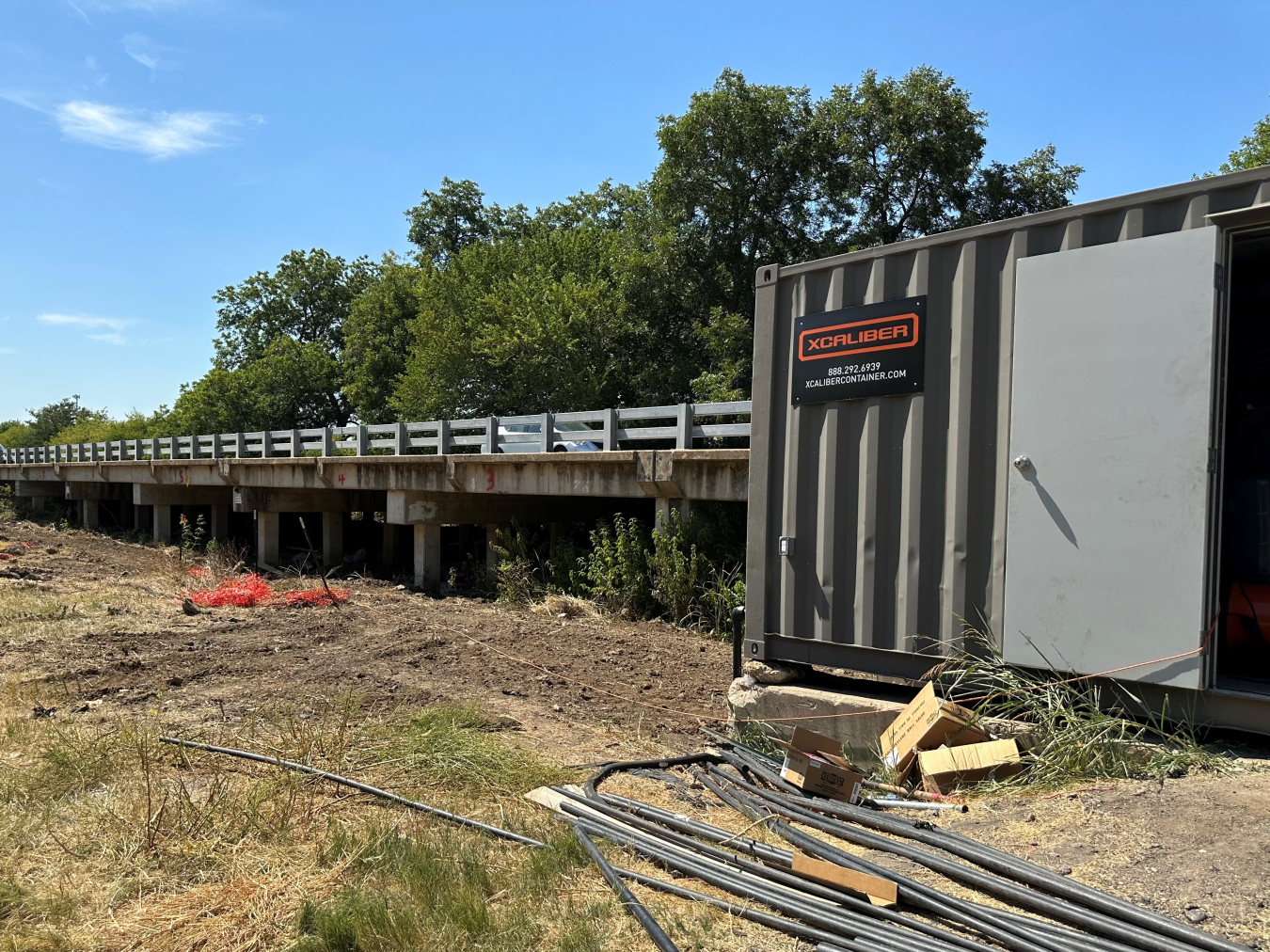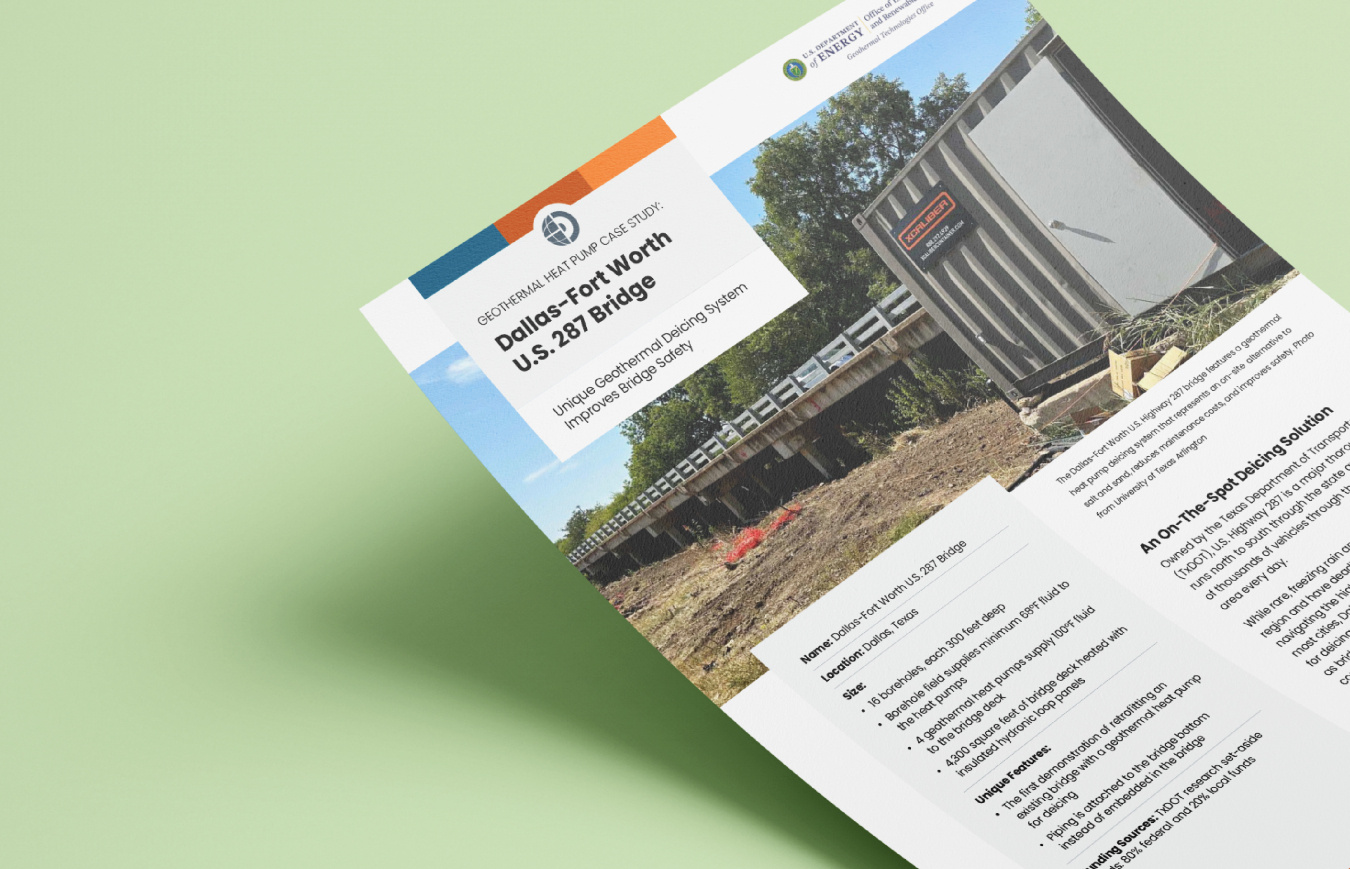
The Dallas-Fort Worth U.S. Highway 287 bridge features a geothermal heat pump deicing system that represents an on-site alternative to salt and sand, reduces maintenance costs, and improves safety. Photo from University of Texas Arlington
Fast Facts
Location: Dallas, Texas
Size:
- 16 boreholes, each 300 feet deep
- Borehole field supplies minimum 68oF fluid to the heat pumps
- 4 geothermal heat pumps supply 100oF fluid to the bridge deck
- 4,300 square feet of bridge deck heated with insulated hydronic loop panels
Download the full case study for additional fast facts.
An On-The-Spot Deicing Solution
Owned by the Texas Department of Transportation (TxDOT), U.S. Highway 287 is a major thoroughfare that runs north to south through the state and carries tens of thousands of vehicles through the Dallas/Fort Worth area every day.
While rare, freezing rain and snow can paralyze the region and have deadly consequences for drivers navigating the highway’s elevated bridges. Like most cities, Dallas uses salt and sand compounds for deicing—but these come with challenges, such as bridge corrosion, pavement damage, and water contamination. Additionally, dispatching salt or sand trucks to handle sudden storms can put staff at risk, and snow removal equipment, labor, fuel, deicing agents, and system maintenance add up to higher costs.
A collaborative research project funded by TxDOT set out to demonstrate the use of geothermal heat pumps (GHPs) for low-impact, on-site bridge deicing.
University Researchers Pilot Novel Idea
In 2015, University of Texas at Arlington professor Dr. Xinbao Yu teamed up with Texas A&M professor Dr. Anand Puppala to propose a research project on the use of geothermal heat pumps to melt ice and snow on bridges, creating an efficient alternative to salt and sand while reducing maintenance costs and, potentially, saving lives. TxDOT recognized the proposal’s safety potential and funded the work.
The project had two phases. The first phase was a conceptual study that used a pilot bridge, mockups, and laboratory testing to validate the idea. The second phase employed students and postdocs of the two universities to implement and study the real-life performance of the geothermal heat pump system installed on one of Highway 287’s many bridges.
For the project, the researchers selected an in-service, Fort Worth bridge close to campus and low to the ground, making it easier for students to conduct field work. They installed a nearby control room containing heat pumps, monitoring instrumentation, and other equipment—including a thermostat that turns the system on automatically.
Keeping Drivers Safe. Pipe loops spaced 6 inches apart insulate 4,300 square feet of bridge deck. The pipe carries warm, geothermally heated fluid that prevents snow and ice from forming on the bridge. Photo from University of Texas at Arlington
Unique Features:
- The first demonstration of retrofitting an existing bridge with a geothermal heat pump for deicing
- Piping is attached to the bridge bottom instead of embedded in the bridge
Funding Sources:
- TxDOT research set-aside funds: 80% federal and 20% local funds
System Benefits Go Beyond Safety
Using 24/7 heat from underground, the geothermal heat pump system keeps the bridge at a constant temperature, preventing ice and snow from forming. This not only ensures driver safety, but also provides a reliable on-site alternative to chemical deicing and the corrosion that results from using these compounds.
The system also offers additional benefits:
- Pipes installed under the bridge deck, rather than embedded inside the concrete of the bridge during construction, allow for easy identification and repair of any leaking pipes.
- Foam-core insulation covering the piping improves system efficiency by ensuring the heat generated by the system goes into the bridge deck, rather than escaping into the air.
- Because the system tubing is installed beneath the bridge deck, existing bridges anywhere can be retrofitted with similar geothermal heat pump systems to keep drivers safe worldwide.
“What we are doing is sound, safe, and efficient. We took the idea of using geothermal heat pumps for bridge deicing to the next level, creating an optimal way of deicing using innovative materials and applications.”
Xinbao Yu, Department of Civil Engineering Professor, University of Texas at Arlington
Contacts:
For questions about this case study, contact Tom Schwerdt, Tom.Schwerdt@txdot.gov.
For any website technical issues or general questions about geothermal heat pumps, contact DOE.Geothermal@ee.doe.gov.
Printable Version
Download the printable Dallas-Fort Worth Bridge case study or visit the Geothermal Heat Pump Case Studies page to see more examples of geothermal heat pumps in action.


